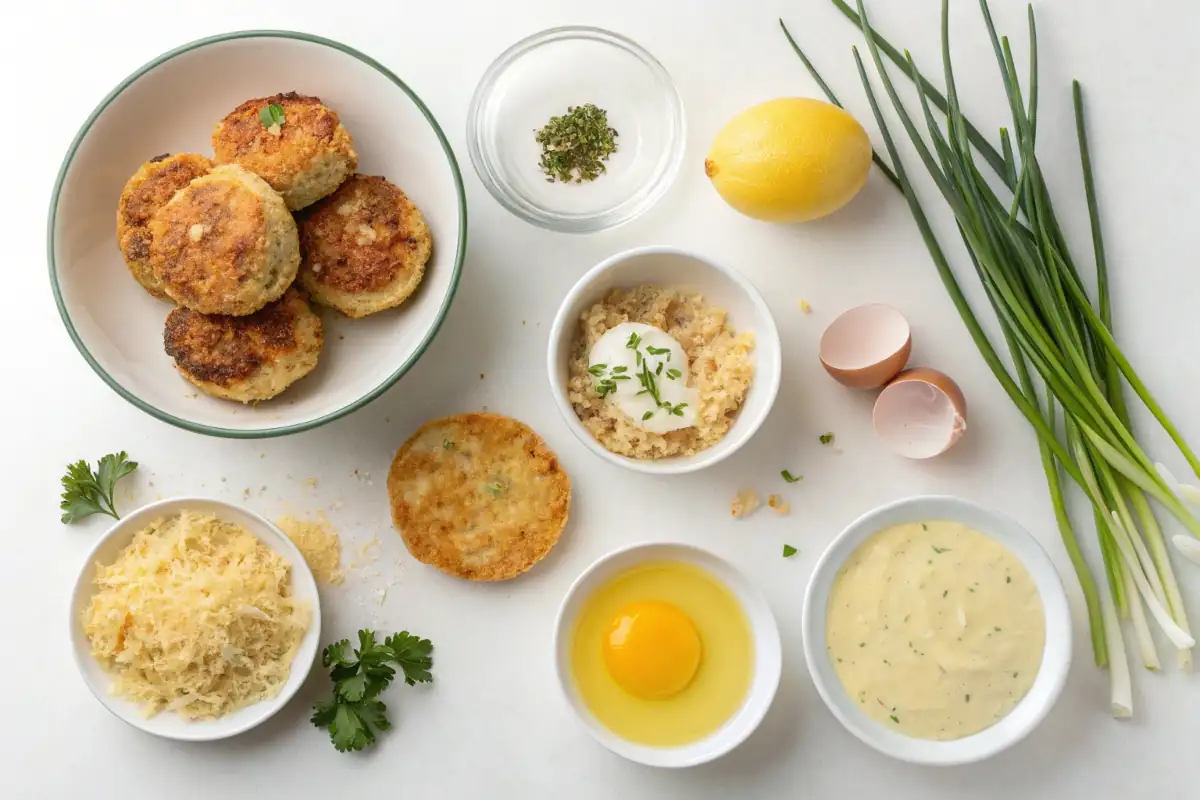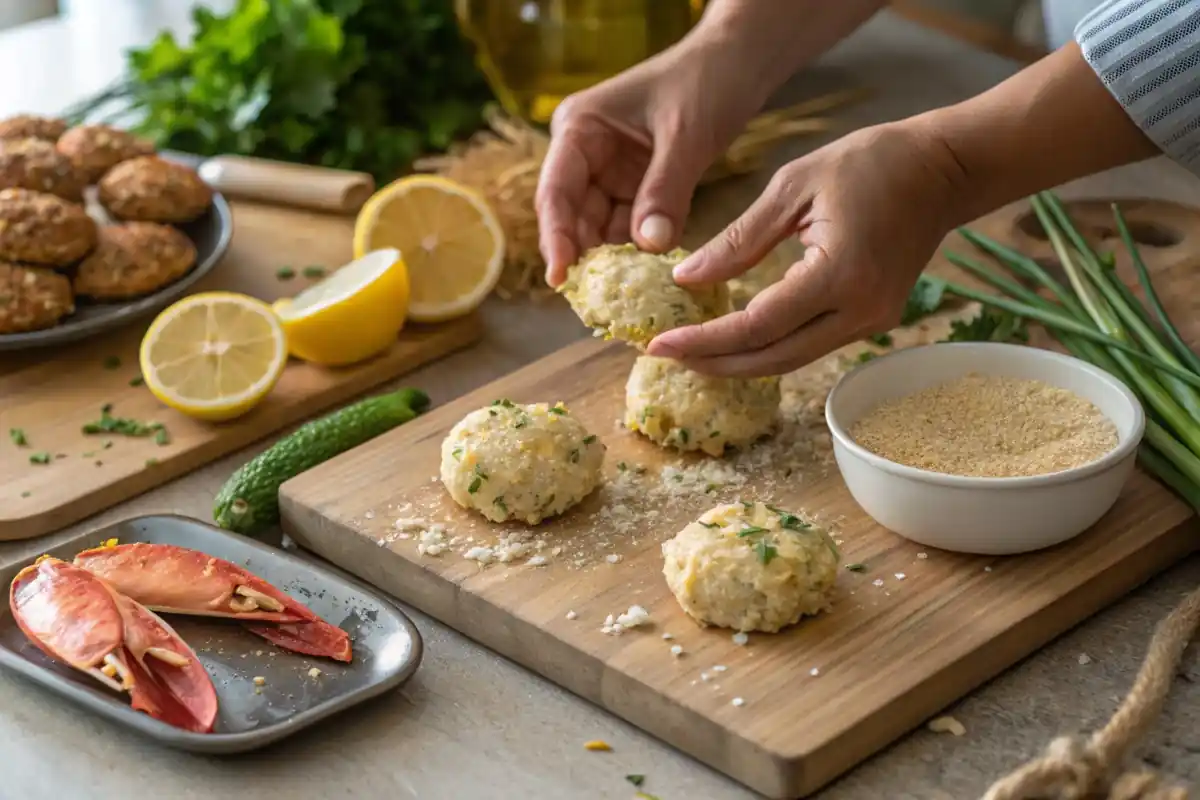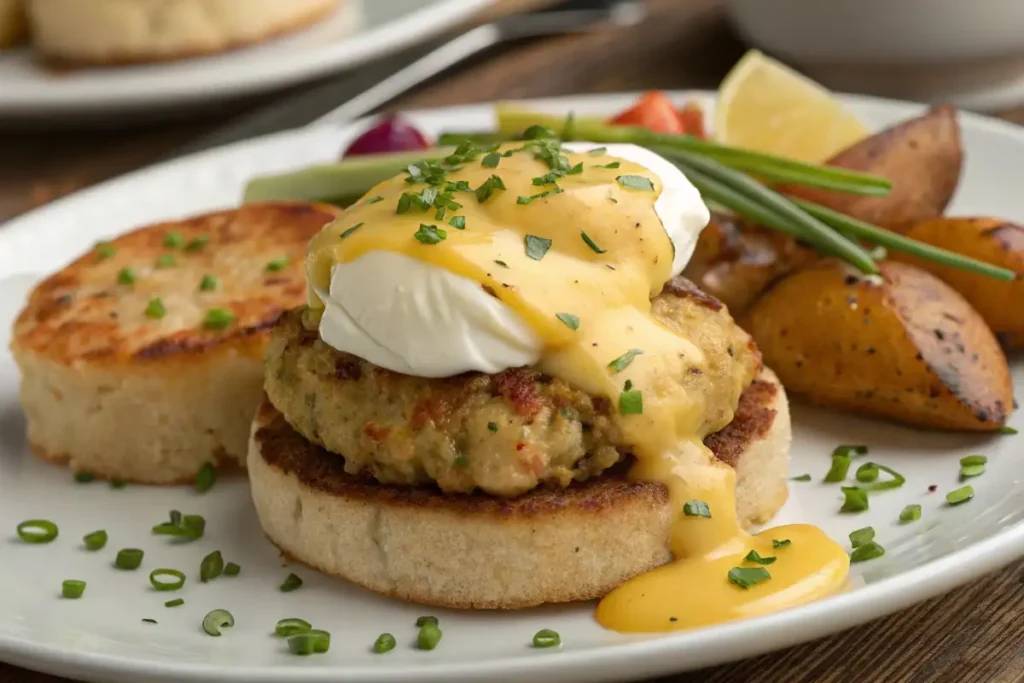Craving a brunch that’s both elegant and satisfying? This crab cake benedict recipe transforms a classic into something truly special. Get ready for a delightful explosion of flavors!
Why You’ll Love This Crab Cake Benedict Recipe
This isn’t your average eggs benedict. This recipe combines the savory deliciousness of crab cakes with the richness of a classic hollandaise. The result? A truly memorable brunch experience. It’s easier to make than you think and will seriously impress your guests (or yourself!). It is perfect for weekend brunches or even a special occasion breakfast.
What is Crab Cake Benedict?
Crab cake benedict is a delicious twist on the traditional Eggs Benedict. It replaces the usual Canadian bacon or ham with a savory crab cake. This adds a unique flavor and texture that complements the poached egg and hollandaise sauce beautifully. The crab cake adds a delightful seafood element to this brunch favorite, making it a truly special treat.

Ingredients
Crab Cake Benedict Ingredients:
For the Crab Cakes (Makes 4):
- 1 pound lump crab meat, picked over for shells
- 1/2 cup Panko bread crumbs
- 1/4 cup mayonnaise
- 1 tablespoon Dijon mustard
- 1 teaspoon Worcestershire sauce
- 1/2 teaspoon Old Bay seasoning
- 1 large egg, lightly beaten
- 2 tablespoons fresh parsley, chopped
- 1 tablespoon fresh lemon juice
- Salt and pepper to taste
- 2 tablespoons oil (vegetable or olive) for cooking
For the Poached Eggs (4 Eggs):
- 4 large eggs, fresh is best
- 1 tablespoon white vinegar
- Water
For the Hollandaise Sauce:
- 3 large egg yolks
- 2 tablespoons fresh lemon juice
- 1/2 cup (1 stick) unsalted butter, clarified and melted (see instructions below)
- Pinch of cayenne pepper
- Salt to taste
For Assembly:
- 2 English muffins, split and toasted
- Fresh parsley or paprika, for garnish

Step-by-Step Cooking Instructions:
1. Prepare the Clarified Butter (for Hollandaise):
- Place the butter in a small saucepan over low heat.
- Let the butter melt slowly. Do not stir.
- As the butter melts, you’ll notice it separates into three layers: a milky foam on top, clear butterfat in the middle, and milk solids at the bottom.
- Carefully skim off the foam from the top with a spoon.
- Gently pour the clear butterfat (the clarified butter) into a heatproof measuring cup or bowl, leaving the milk solids behind in the saucepan. Discard the milk solids.
- Keep the clarified butter warm until ready to use for the hollandaise sauce.
2. Make the Crab Cakes:
- In a medium bowl, gently combine the lump crab meat, Panko bread crumbs, mayonnaise, Dijon mustard, Worcestershire sauce, Old Bay seasoning, beaten egg, fresh parsley, and lemon juice.
- Season with salt and pepper to taste. Be careful not to over-season, as Old Bay seasoning can be salty.
- Gently mix all the ingredients until just combined. Avoid overmixing, as this can make the crab cakes tough.
- Divide the crab mixture into four equal portions.
- Gently shape each portion into a patty about 3/4 inch thick.
- Heat the oil in a large skillet over medium heat.
- Carefully place the crab cakes in the hot skillet.
- Cook for 3-4 minutes per side, or until golden brown and heated through. The internal temperature should reach 165°F (74°C).
- Alternatively, you can bake the crab cakes in a preheated oven at 375°F (190°C) for 15-20 minutes, or until golden brown and heated through.
- Keep the cooked crab cakes warm in a low oven (200°F/93°C) while you prepare the remaining components.
3. Poach the Eggs:
- Fill a large, deep skillet or saucepan with about 3 inches of water.
- Bring the water to a gentle simmer over medium heat. You should see small bubbles forming, but the water should not be boiling vigorously.
- Add the white vinegar to the water.
- Crack each egg into a small bowl. This makes it easier to gently slide the egg into the water.
- Using a spoon, create a gentle swirl in the simmering water.
- Carefully slide one egg at a time into the center of the swirling water.
- Cook for 3-4 minutes, or until the egg white is set and the yolk is still runny.
- Use a slotted spoon to carefully remove the poached egg from the water.
- Place the poached egg on a paper towel-lined plate to drain excess water.
- Repeat with the remaining eggs.
4. Make the Hollandaise Sauce:
- Fill a saucepan with about 1-2 inches of water and bring it to a gentle simmer over medium heat.
- Find a heatproof bowl that fits snugly over the saucepan without touching the water. This creates a double boiler.
- In the heatproof bowl, whisk together the egg yolks and lemon juice until pale and slightly thickened.
- Place the bowl over the simmering water. Make sure the bowl doesn’t touch the water.
- Continue whisking the egg yolk mixture constantly until it becomes thick and foamy, about 2-3 minutes. The mixture should be light yellow and have doubled in volume.
- Remove the bowl from the heat.
- Slowly drizzle the warm clarified butter into the egg yolk mixture, whisking constantly and vigorously. It’s crucial to add the butter slowly to emulsify the sauce and prevent it from curdling.
- Continue whisking until all the butter has been incorporated and the sauce is smooth, creamy, and thick.
- Season the hollandaise sauce with a pinch of cayenne pepper and salt to taste.
- If the hollandaise sauce becomes too thick, whisk in a teaspoon of warm water at a time until it reaches the desired consistency.
- Keep the hollandaise sauce warm in a warm spot until ready to use. If it sits for too long, it may start to separate.
5. Assemble the Crab Cake Benedict:
- Lightly toast the English muffin halves.
- Place one crab cake on each toasted English muffin half.
- Carefully place one poached egg on top of each crab cake.
- Generously drizzle the hollandaise sauce over the poached eggs.
- Garnish with fresh parsley or a sprinkle of paprika.

6. Serve Immediately:
Serve the crab cake benedict immediately while it’s warm and delicious. Enjoy
Embracing the Flavors of Crab Cake Benedict
This crab cake benedict recipe is more than just a meal; it’s an experience. It’s about taking a classic dish and elevating it with delicious, fresh flavors. It is also about sharing it with loved ones. So gather your ingredients, put on your apron, and get ready to create a brunch that will impress. The flavor combination is unbeatable.
Perfect for Special Occasions
This crab cake benedict is not just for everyday brunch. It’s perfect for special occasions like:
- Mother’s Day Brunch: Show Mom how much you care with this elegant brunch.
- Anniversaries: Celebrate your love with a romantic brunch for two.
- Holiday Brunch: This dish is sure to impress at any holiday gathering.
- Birthday Brunch: A delicious way to start a birthday celebration.
Elevated brunch dishes are excellent for impressing guests. They show care and thoughtfulness.
The Art of Plating
Presentation matters! Here are a few tips for plating your crab cake benedict like a pro:
- Use a White Plate: White plates allow the colors of the dish to pop.
- Arrange Artfully: Place the benedict in the center of the plate and arrange the side dishes around it.
- Garnish Generously: Don’t be afraid to garnish with fresh herbs or a sprinkle of paprika.
- Drizzle Strategically: Drizzle extra hollandaise sauce around the plate for an elegant touch.
Elegant plating enhances the dining experience. It shows attention to detail.
Crab Cake Benedict: A Recipe to Share
This recipe is so good, you’ll want to share it with everyone!
- Print the Recipe: Print out the recipe and give it to friends and family.
- Share on Social Media: Post photos of your crab cake benedict on social media.
- Host a Brunch: Invite your friends over for a crab cake benedict brunch.
- Pass Down the Tradition: Make this recipe a family tradition.
Sharing this recipe brings joy to others. It creates opportunities for shared experiences.
Mastering the Hollandaise
Let’s talk more about the hollandaise sauce. It’s the soul of this dish.
- Temperature is Key: Keep the heat low and consistent. Too much heat will curdle the sauce.
- Slow and Steady: Drizzle the melted butter in slowly and steadily while whisking constantly.
- Rescue a Curdled Sauce: If the sauce curdles, remove it from the heat and whisk in a tablespoon of cold water.
- Flavor Boosters: Add a pinch of cayenne pepper, a dash of hot sauce, or a squeeze of lemon juice to enhance the flavor.
Perfecting hollandaise sauce takes practice. But the reward is a smooth and flavorful sauce.
Sourcing Quality Ingredients
Quality ingredients make all the difference in this recipe.
- Crab Meat: Choose fresh lump crab meat from a reputable seafood market.
- Eggs: Use fresh, high-quality eggs.
- Butter: Opt for unsalted butter and clarify it yourself for the best flavor.
- English Muffins: Choose high-quality English muffins that are sturdy enough to hold the crab cake and egg.
Using quality ingredients ensures optimal flavor. It elevates the final product.
Healthier Swaps
Looking to make this crab cake benedict a little healthier?
- Whole Wheat English Muffins: Use whole wheat English muffins for added fiber.
- Greek Yogurt Hollandaise: Substitute some of the butter in the hollandaise sauce with Greek yogurt for a lower-fat option.
- Baked Crab Cakes: Bake the crab cakes instead of frying them to reduce fat.
- Add Greens: Add a bed of fresh spinach or arugula underneath the benedict for added nutrients.
Healthier options allow you to enjoy the dish guilt-free. They offer a lighter take on the classic recipe.
A Culinary Adventure
Making crab cake benedict is a culinary adventure. Each step, from creating the crab cakes to poaching the eggs, is a chance to learn and improve your skills. Embrace the process, and enjoy the delicious results. The dish allows you to refine cooking abilities.
The Story Behind Benedict
Ever wondered about the history of Eggs Benedict? While there are a few competing stories, the most popular one involves a Wall Street broker named Lemuel Benedict. In 1894, he ordered “buttered toast, poached eggs, crisp bacon, and a hooker of hollandaise” at the Waldorf Hotel. The maître d’ was so impressed, he put it on the menu, swapping out bacon for ham and toast for English muffins. So, while the crab cake benedict is a modern twist, it’s rooted in a classic! The original is a piece of culinary history.
Elevating the Crab Cake Component
Let’s delve deeper into making truly exceptional crab cakes, the heart of this Benedict. The quality of crab meat is paramount. Seek out jumbo lump crab meat whenever available. It’s more expensive, but the flavor and texture are unmatched. Jumbo lump crab meat consists of whole muscle pieces, offering a sweet and succulent bite.
- Binding Agent Alternatives: Instead of relying solely on mayonnaise, try incorporating a small amount of crème fraîche or sour cream. These options add a tangy depth and can lighten the texture.
- Flavor Enhancers: Don’t underestimate the power of fresh herbs. Besides parsley, consider adding finely chopped chives, dill, or even tarragon to the crab cake mixture. Each herb imparts a unique aromatic note that can elevate the overall flavor profile. A touch of sherry or dry vermouth can also add complexity.
- Spice it Up: A pinch of smoked paprika can introduce a subtle smoky note that complements the sweetness of the crab. If you prefer a more pronounced heat, add a finely minced jalapeño or a dash of your favorite hot sauce.
- Cooking Methods Compared: While pan-frying crab cakes delivers a satisfyingly crisp exterior, baking them can be a healthier option. Baking also allows for more even cooking, preventing the crab cakes from becoming dry or overcooked on the outside. Air frying is another excellent choice, offering a crisp texture with minimal oil.

Mastering Poached Eggs: Advanced Techniques
Achieving perfectly poached eggs consistently requires attention to detail. While the basic method is straightforward, these advanced techniques can help you elevate your poaching game:
- The Strainer Method: Crack each egg into a fine-mesh strainer and gently swirl it. This removes the thin, watery egg whites that tend to spread out and create wispy strands in the poaching water.
- Acidulated Water: Adding vinegar to the poaching water helps the egg whites coagulate faster. Some chefs prefer using lemon juice for a milder flavor. Experiment to see which you prefer.
- Water Temperature Control: The water should be gently simmering, not boiling vigorously. Too much heat will cause the eggs to break apart and become rubbery.
- The “Sous Vide” Hack: For foolproof poaching, consider using a sous vide immersion circulator. Set the temperature to 145°F (63°C) and cook the eggs in their shells for about 45 minutes. The result is perfectly poached eggs with incredibly tender whites and creamy yolks.
- Holding Poached Eggs: If you’re preparing poached eggs ahead of time, you can hold them in an ice bath to stop the cooking process. When ready to serve, gently reheat them in warm water for a few seconds.
Deconstructing the Hollandaise: Beyond the Basics
While the classic hollandaise is delicious, there are numerous ways to customize it to create truly unique variations:
- Infused Butter: Infuse the melted butter with aromatics like garlic, herbs, or spices before adding it to the egg yolks. This imparts a subtle yet distinct flavor to the sauce.
- Citrus Variations: Experiment with different citrus juices besides lemon. Lime juice adds a zesty twist, while orange juice offers a sweeter and more aromatic flavor.
- Spicy Hollandaise: Add a pinch of cayenne pepper, a dash of hot sauce, or a finely minced jalapeño to the hollandaise sauce for a spicy kick.
- Brown Butter Hollandaise: Use brown butter instead of clarified butter for a nutty and complex flavor. Be careful not to burn the butter.
- Vegan Hollandaise: For a vegan option, replace the egg yolks with cashew cream or silken tofu. Use plant-based butter or olive oil instead of dairy butter.
Crab Cake Benedict: a Culinary Canvas
The crab cake benedict, at its heart, is a platform for creative culinary expression. It invites experimentation and flavor exploration. Don’t be afraid to try new things and make it your own. Each element, from the crab cake to the hollandaise, presents opportunities for innovation. So embrace the adventure, and let your taste buds guide you. It will be an experience!
Frequently Asked Questions (FAQs)
What is a crab benedict?
Crab benedict is a variation of the classic Eggs Benedict. It replaces the traditional Canadian bacon or ham with a crab cake, adding a savory seafood flavor.
What are crab cakes made of?
Crab cakes are typically made with crab meat, bread crumbs, mayonnaise, Dijon mustard, Worcestershire sauce, Old Bay seasoning, egg, fresh parsley, and lemon juice.
What does “Benedict” mean in food?
“Benedict” in food refers to a dish consisting of an English muffin topped with a protein (traditionally ham), a poached egg, and hollandaise sauce.
What is crab cake sauce made of?
While not all crab cakes are served with sauce, a common sauce to complement them is a remoulade, which is typically made with mayonnaise, Dijon mustard, fresh herbs, and spices.

